Build Your Skin Care Routine
Healthy skin doesn’t happen overnight. A consistent skin care routine is essential to optimize your skin’s health, fortify its defenses and maximize your results.
- Follow these essential skin care steps
- Customize your skin care routine
- Enhance your routine with professional spa treatments
Skin Care Steps
To select a skin care routine, we highly recommend booking a facial with a knowledgeable, certified professional. Estheticians have the experience and training to recommend professional treatments that boost your results as well as educated guidance for your home skin care routine.
To enhance your knowledge, we’ve compiled the essential steps for a skin care routine as well as additional recommendations tailored to your unique skin type and concerns.

Apply your skin care products in the following order for optimal results:
- Cleanse
- Tone: Essence, Facial Mist or Toner
- Exfoliate
- Mask
- Treat: Serum, Concentrate or Facial Oil
- Moisturize
- Eye Care
- Protect/SPF
- Body Care
1. Cleanse
Twice per day, morning and night.
A thorough cleanse removes oil and debris, helping prevent clogged pores and dullness. It prepares your skin for other treatments, enhancing ingredient absorption. Choose a cleanser type (oil, balm, gel, or cream) based on your skin type and concerns.
2. Tone: Essence, Facial Mist, or Toner
Twice per day, morning and night.
Toning replenishes your skin with vitamins and minerals, enhancing the effectiveness of cleansing. Modern toners, essences, and mists support skin health, similar to how conditioner works after shampoo.
3. Exfoliate
Once or twice per week.
Exfoliating promotes cell turnover, clears buildup, and reduces pore congestion. Options range from gentle exfoliants to professional peels. Consult a skincare expert to determine the best method.
Watch the video below to learn proper exfoliation:
4. Mask
Once or twice per week.
Masks deliver concentrated vitamins and nutrients, supporting hydration, firmness, and specific skin concerns (e.g., acne, large pores, dark spots).
5. Treat: Serum, Concentrate, or Facial Oil
Twice per day, morning and night.
Use potent serums, concentrates, or facial oils to target skin concerns and environmental stressors. Choose based on your specific skin goals.
6. Moisturize
Twice per day, morning and night.
Moisturizers keep skin soft, support the lipid barrier, and retain moisture. Suitable for all skin types, including oily skin.
7. Eye Care
Twice per day, morning and night.
The eye area needs special care due to its thinner skin. Regular eye cream reduces fine lines, dark circles, and puffiness.
8. Protect/SPF
Daily, or as required.
Daily sunscreen protects against UV damage, premature aging, and other skin issues. Use a broad-spectrum SPF year-round.
9. Body Care
Daily, or as required.
Extend your skincare routine to your body using nutrient-rich products to maintain strong, youthful skin from head to toe.
How To Customize Your Skin Care Routine
Work with your esthetician to tailor your routine to your skin type and concerns.
Skin Types
Skin types are determined by genetics, influencing oil production, pore size, and skin texture. Manage it with proper care.
Explore five main skin types:
Skin Type Test
Take a simple test to identify your skin type: normal, dry, oily, combination, or sensitive.
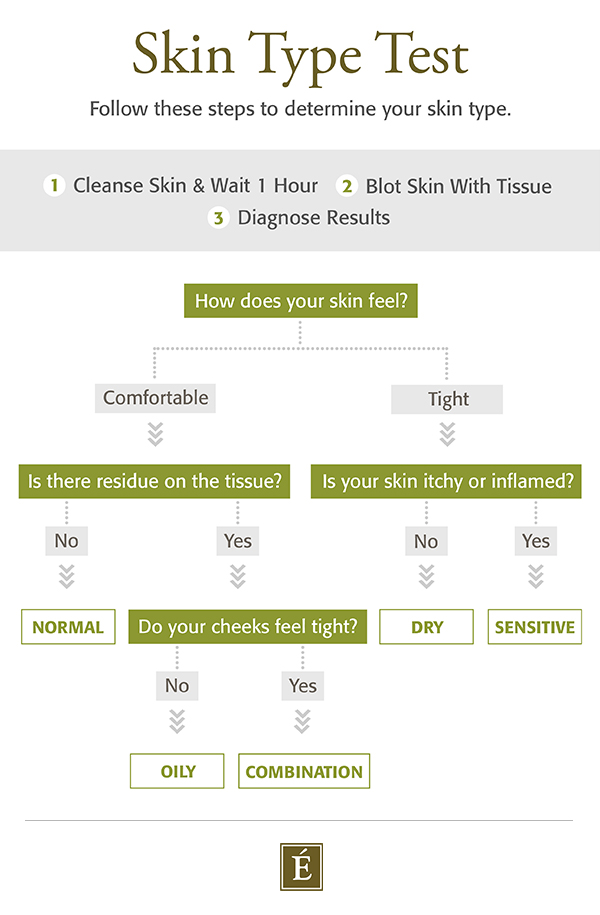
1. Normal Skin
“Normal” skin is best described as well-balanced. It has even moisture and hydration and uniform texture, with small pores and no apparent problem areas. Those with normal skin types may experience occasional dryness or oiliness as well as the odd breakout. Overall, normal skin looks and feels healthy but may experience mild dryness or oiliness as well as the occasional breakout, particularly when exposed to environmental stress.
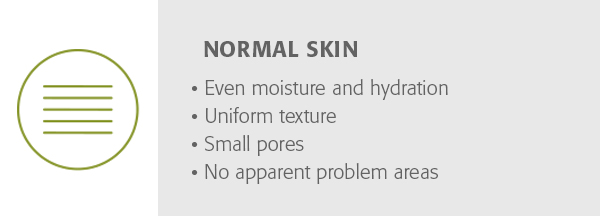
For normal skin, focus on maintaining health and protection. Use antioxidants and adjust your routine based on current conditions. If experiencing dryness, opt for hydrating products; if oily or prone to breakouts, use balancing and clarifying products.
2. Dry Skin
Dry skin produces less oil, lacks moisture retention, and can feel tight or flaky. It often has nearly invisible pores and more visible fine lines, especially around the eyes and lips. Use products that provide deep hydration and support skin’s natural moisture barrier.
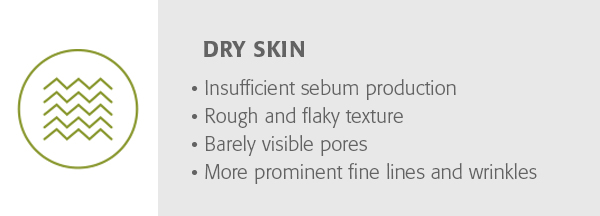
To maintain normal skin, use products rich in antioxidants and adjust your routine as needed. For dryness, use hydrating products; for oiliness or breakouts, use balancing products that target blemishes.
For dry skin, use moisture-rich products like oil or cream cleansers and daily moisturizers. A rich night cream helps repair skin while you sleep. Weekly moisturizing masks can plump and soften the skin, reducing the appearance of fine lines and wrinkles.
3. Oily Skin
Oily skin has overactive sebaceous glands, producing excess sebum. While sebum keeps the skin’s moisture barrier intact, too much can lead to a shiny complexion, visible pores, and breakouts. Though fine lines and wrinkles are less noticeable, proper care is needed to control shine and prevent breakouts.

The goal for an oily skin care routine is to control excess oil and maintain skin’s hydration. When dehydrated, skin will react by producing more oil; you can counteract this activity by hydrating skin with a lightweight moisturizer containing humectants like botanical hyaluronic acid. Also, consider adding an oil cleanser to your skin care routine. While it may seem counterintuitive, the oil in the cleanser will attract excess sebum, allowing you to rinse it away without stripping your skin.
Watch the video below to learn how to add an oil cleanser to your routine skin care routine.
4. Combination Skin
Combination skin is characterized by non-uniform oil production and appears neither overly dry nor oily. With more active oil glands in the T-zone and less active glands elsewhere, combination skin will tend towards oiliness on the forehead, jaw and nose, and dryness on the cheeks, jawline and hairline.

The best approach for combination skin care is often to divide and conquer, treating different parts of the face with different products and techniques. For morning, a gentle foaming cleanser will absorb excess oil. At night, a cream-based cleanser will replenish lost moisture. Multi-masking can be extremely beneficial for combination skin. This skin care technique involves applying two or more face masks, such as a clay-based mask and a cream-based mask, to different areas of the face so that multiple concerns are addressed at once.
5. Sensitive Skin
Sensitive skin is quite common and, according to the American Academy of Dermatology, affects 50% of people. This skin type has fine pores, can be easily irritated and is prone to redness. Often, it will react negatively to poor lifestyle habits, climate and weather changes, hormonal imbalances and harsh cosmetic ingredients.
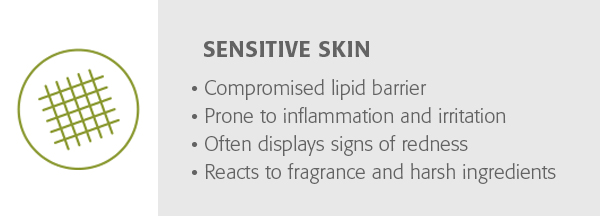
Sensitive skin varies widely in symptoms and severity. To manage sensitive skin, use gentle, soothing products that heal and relieve irritation. Gentle peels can be used to exfoliate without worsening sensitivity. Opt for calming natural ingredients like chamomile and calendula to comfort reactive skin.
Skin Concerns & Conditions
Unlike skin types, concerns and conditions are not genetic and can be improved over time. They are often triggered by external factors like climate, lifestyle, and environmental stressors. With the right treatments containing active herbal ingredients, these concerns can be effectively managed.
Common skin concerns and conditions include:
Acne
Acne affects up to 80% of people at some point in their lives, impacting all ages and skin types. It is caused by factors like pore congestion, excess oil production, hormonal changes, bacteria, and genetics. Effective skincare can alleviate acne over time, keeping the skin clear and healthy.
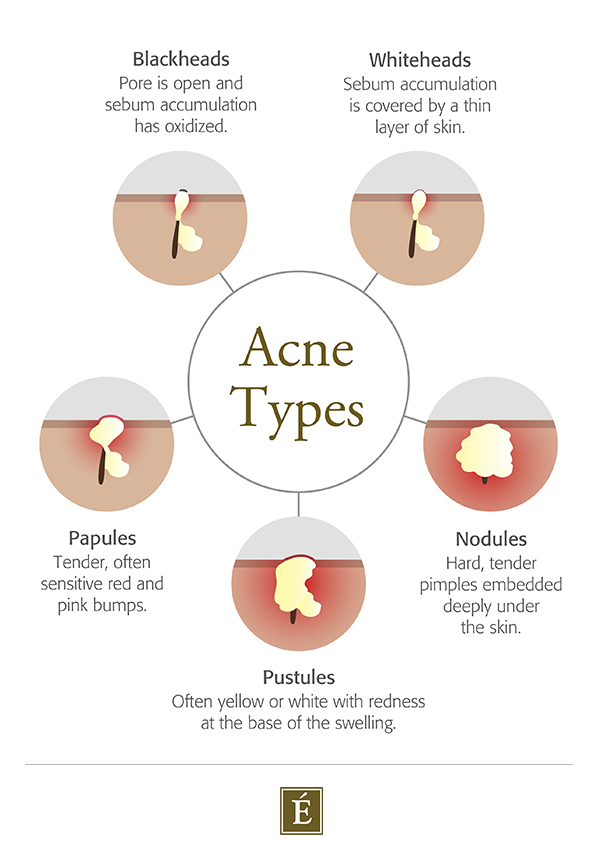
Salicylic acid and clay are ideal for treating acne-prone skin and preventing breakouts. Salicylic acid is a beta hydroxy acid that clears blockages deep in the pores, while clay draws out impurities from the skin’s surface.
Watch the video below for an acne treatment routine:
For moderate to severe acne, professional spa treatments can be beneficial. Acne facials use deep cleansing methods, professional peels, and extractions to clear blackheads and whiteheads.
Redness
Rosacea often appears as redness on the nose, forehead, cheekbones, or chin due to inflamed capillaries. While genetic, triggers like extreme temperatures, alcohol, and sun exposure can worsen symptoms. Use gentle, paraben-free products with soothing ingredients like chamomile and calendula to reduce redness.
Large Pores
Large pores are often linked to genetics but can be enlarged by dead skin buildup, oil production, and loss of elasticity. They are common in oily and combination skin types with overactive sebaceous glands.
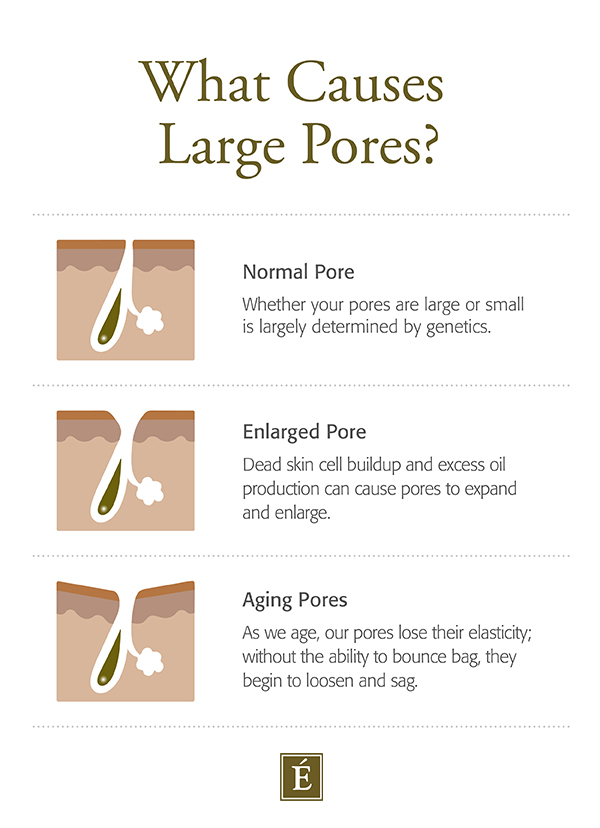
Regular cleansing and gentle exfoliation are essential for minimizing large pores. These steps help remove sebum and clear congestion, allowing pores to return to their normal size. Clay and charcoal masks have astringent properties that tighten and reduce pore appearance.
Dehydration
Dehydrated skin lacks water, which can affect all skin types, even oily skin. Symptoms include itchiness, sensitivity, dullness, and fine lines. External elements, poor diet, and lifestyle choices can contribute to dehydration.
Watch the video below to determine if you have dehydrated skin:
One of the best ways to hydrate dehydrated skin is to add products with botanical hyaluronic acid to your skincare routine. This ingredient inhibits hyaluronidase (an enzyme that breaks down hyaluronic acid) and supports hyaluronic synthesis in the skin. Serums and moisturizers containing botanical hyaluronic acid help keep skin hydrated, plump, and healthy.
Signs Of Aging
Primary signs of aging include fine lines, wrinkles, and sagging skin, caused by reduced production of hyaluronic acid, collagen, and elastin over time. This natural process accounts for only 10% of skin aging, while the remaining 90% is due to oxidative stress from long-term exposure to free radicals, accelerating the aging process.
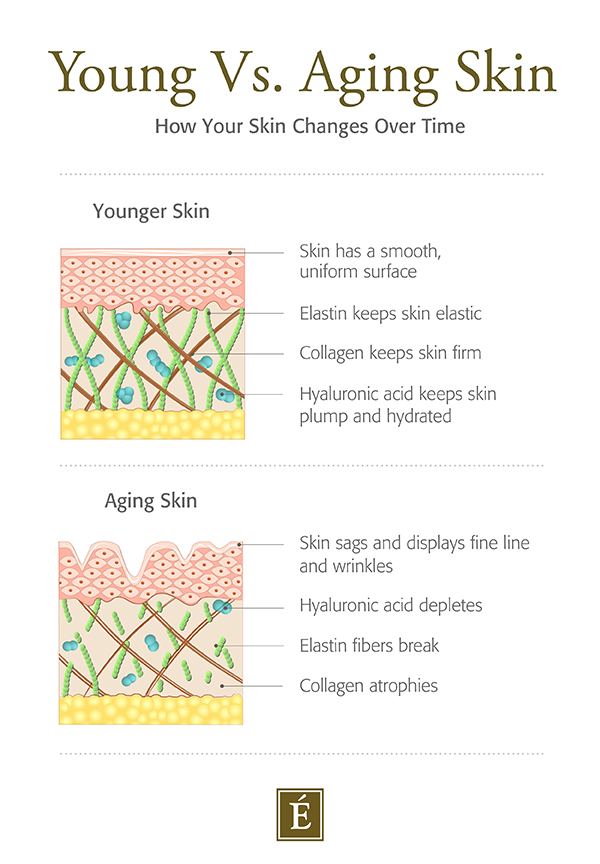
While aging is inevitable, its visible effects can be minimized with a targeted skincare routine. Aging skin often becomes dry, so it’s beneficial to follow a dry skin care regimen with specific adjustments. Use serums, oils, and concentrates containing botanical peptides, hyaluronic acid, and natural retinol alternatives to plump, lift, and firm the skin. Antioxidant-rich products can help protect against environmental stress and free radical damage.
Lack Of Firmness
Loss of firmness is another effect of aging. Over time, muscles in the body and face can lose tone and elasticity. As muscle fibers and elastin lengthen due to aging, lifestyle, and nutrition, skin can begin to sag. This results in drooping eyebrows, eyelids, and a loosening under the cheeks and jaw (jowls).
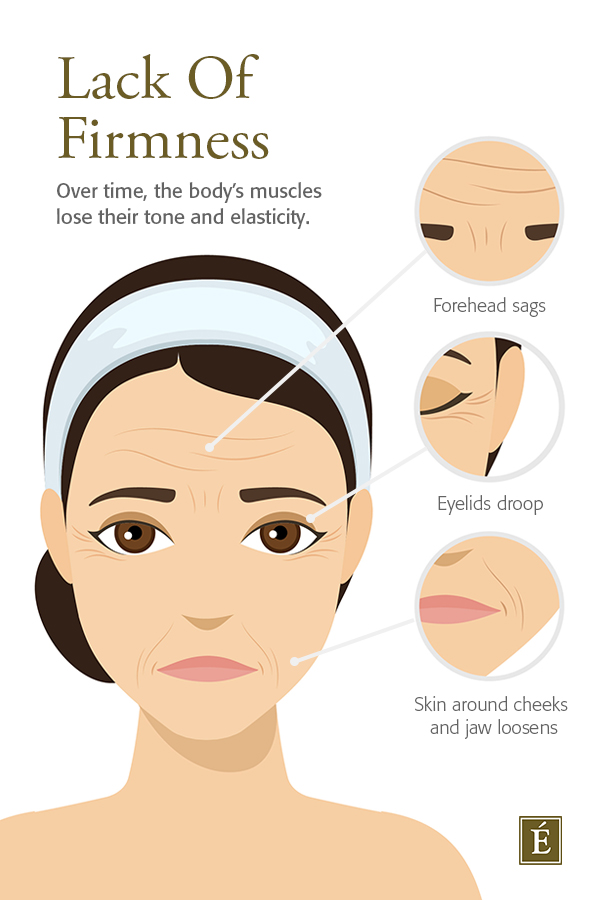
Lack of firmness can be improved with a targeted skincare routine that enhances skin tightness and elasticity. Add face masks and moisturizers containing natural firming agents like bamboo to your routine. Incorporate facial massage techniques to tone underlying muscles and maintain firmness.
Hyperpigmentation
Hyperpigmentation, one of today’s leading skin concerns, includes dark spots, freckles, scarring, or uneven skin tone. It’s caused by increased melanin production due to sun exposure, stress, aging, hormonal changes, and post-inflammatory pigmentation. It varies in severity and affects all skin types.
This condition is challenging to treat and requires consistent, targeted skincare. Certified Esthetician Alicia Hawthorne suggests using serums and moisturizers with brightening ingredients like stone crop, natural hydroquinone alternatives, licorice root, willow bark, arbutin, and zinc hyaluronate.
Watch the video below for tips on diminishing dark spots:
Sun Damage
UV exposure causes both temporary and long-term skin damage. Immediate effects include dehydration and redness, while long-term exposure can lead to permanently stretched blood vessels, resulting in a blotchy complexion. To prevent sun damage, use SPF moisturizers or mineral powder sunscreen daily, and protect your entire body with natural sunscreen. After sun exposure, replenish lost moisture with hydrating balms and body lotions.
Spa Treatments
Along with a good home care routine, professional treatments are essential for enhancing your skin’s health. Spa treatments combine professional techniques, advanced products, and the skills of licensed estheticians for better results. These treatments can be tailored to your skin type and concerns and can be maintained with a consistent routine at home.
Steps In A Professional Treatment
Here’s what you can expect during a spa treatment:
- Assessment: Discussion of skin concerns and routine.
- Cleansing: Removal of makeup and buildup.
- Skin Analysis: Examination of skin’s condition using magnification.
- Steaming: Steam is used to soften congestion and aid extractions.
- Exfoliating: Professional exfoliating treatments like AHA/BHA peels remove dead skin cells.
- Extractions: Clearing of blackheads and whiteheads, if needed.
- Facial Massage: Massage helps relax muscles and improves product absorption.
- Masking: Application of face masks suited to your skin concerns.
- Finishing: Application of toner, serums, moisturizers, eye care, and SPF.
Find A Spa
Consulting with a licensed esthetician is the best way to receive tailored recommendations and maximize your skincare results.
